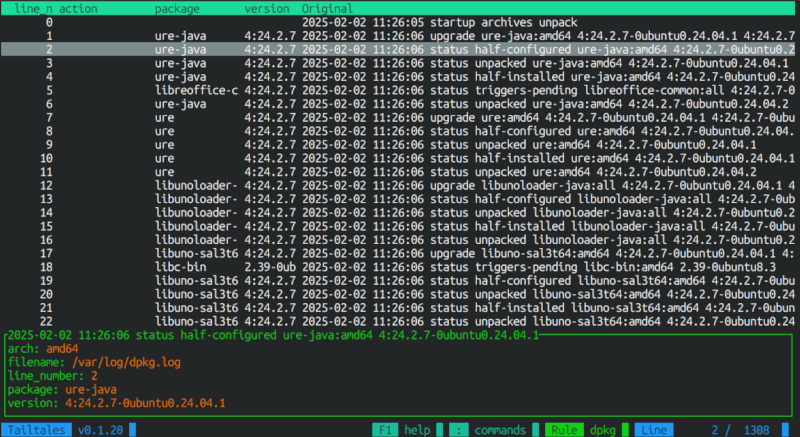25 releases
| 0.1.24 | Apr 21, 2025 |
|---|---|
| 0.1.23 | Apr 16, 2025 |
| 0.1.20 | Feb 7, 2025 |
| 0.1.19 | Jan 31, 2025 |
#467 in Command-line interface
248 downloads per month
520KB
3K
SLoC
TAIL TALES
A TUI log viewer written in Rust
Objetives
To easy inspect existing logs or streaming logs, with some filters, marking of messages and easy finding information in the logs.
Use
- Can set default command or file to open:
tt - Can read exisitng files, checks for changes:
tt /var/log/messages - Can be used as pipe destination:
journalctl -f | tt - Can execute commands and show stdout / stderr:
tt !journalctl -f-- AS bash does not like use of!in commands there is an alternative format:tt -- journalctl -f. Another option istt \!journalctl -f.
Commands
All keybindings are transalted to internal commands. It's possible to execute commands directly entering command mode (: by default).
| Command | Description |
|---|---|
| quit | Exit the application |
| clear | Refresh the screen, usefull when its damaged because of non controlled ANSI characters |
| command | Opens command mode with a new command (not enough with mode command as that woudl not clear the current command) |
| exec | Executes a command, as wl-copy, xdg-open.. or any helper. With placeholders you can pass the original line or urlencoded |
| search_next | Search for the next occurrence |
| search_prev | Search for the previous occurrence |
| vmove | Move vertically, positive down, negative up |
| hmove | Move horizontally, positive right, negative left |
| vgoto | Goto to specific line number |
| clear_records | Clear all records |
| warning <msg...> | Display a warning message |
| toggle_mark | Toggle a mark on the current line. Its a data for the record with that color as mark, and will be used at render. |
| move_to_next_mark | Move to the next marked line |
| move_to_prev_mark | Move to the previous marked line |
| settings | Open the xdg program with the local settings file. If the file does not exist yet it is created with the default settings. |
| mode | Switch between different modes: normal, command, search or filter |
| toggle_details | Toggle the display of details |
Keybindings
| Key | Command |
|---|---|
| : | command |
| | | mode filter |
| f | mode filter |
| / | mode search |
| n | search_next |
| shift-n | search_prev |
| control-del | clear_records |
| control-l | refresh_screen |
| F1 | exec xdg-open https://github.com/davidmoreno/tailtales/#use |
| F2 | exec xdg-open https://www.perplexity.ai/search/new?q={{lineqs}} |
| F3 | exec xdg-open https://www.duckduckgo.com/?q={{lineqs}} |
| F4 | exec xdg-open https://google.com/search?q={{lineqs}} |
| q | quit |
| control-c | -- copy to clipboard -- |
| up | vmove -1 |
| k | vmove -1 |
| page up | vmove -10 |
| down | vmove 1 |
| j | vmove 1 |
| page down | vmove 10 |
| left | hmove -1 |
| control-left | hmove -10 |
| right | hmove 1 |
| control-right | hmove 10 |
| home | vgoto 0 |
| end | vgoto 2000000000 |
| G | goto_line |
| space | toggle_mark yellow |
| 1 | toggle_mark red |
| 2 | toggle_mark green |
| 3 | toggle_mark blue |
| 4 | toggle_mark magenta |
| 5 | toggle_mark cyan |
| tab | move_to_next_mark |
| shift-back tab | move_to_prev_mark |
| esc | mode normal |
| v | toggle_details |
Settings
It comes with some sensible default settings from the settings.yaml file. It can overwriten, by section at
~/.config/tailtales/settings.yaml or the appropiate XDG config directory. See the file for further information.
Rules
The settings file have several default rules, and more may be added (send your pull request with new file formats!).
It has a basic pattern on the file name to discover which rules to use and acording to the matrched rule it can set:
- Data extractors: as logfmt, patterns and regex. These extracted data allows easy filtering and search.
- Columns: From the extracted data, it can show some data into the columns.For example to easily format timestamp or processing time.
- Filters: Acording filters from the filtering language, allows to color the lines, or add a gutter (symbol at the left of the table).
Filter Language
Its possible to search and filter based on both the line and the structured parsed contents.
- Just
textwill look for text - The proper way is
"text", but if just a simple text is given its understood as text (converts the variable name to a string) ~ regexor better~ "regex"can also be used to search / filter by regex- Basic operations as >, <, >=, <=, ==, != between variablers (record fields) and strings or numbers
More will be added.
Example expressions
INFO"^INFO-- The closing " is assumedtimestamp <= "2025-01-01"-- The comparison is string based, so timestamps better in ISO formatline_number > 1000 && line_number < 2000-- TODO, no priority, no parenteheiss, will not work
Features
- TUI
- Read a log file and be able to navigate using arrows and simple search commands
- Read stdout/stderr from executed commands
- Filter messages with some simple expressions
- Parse the lines and provide a formated simple dictionary (key:value). Can see the log lines and the formatted data. Firswt version bassed on patterns.
- Logfmt format parsing
- Pattern format parsing
- Regex format parsing
- Filtering language
- Filtering and marking based on these filters
- Streaming input. Changes in the file, or pipe in, or executed command are seen inmediately.
- As it may have many many lines, be able to scroll efficiently
- Never blocking
Dependencies
~15–26MB
~416K SLoC

